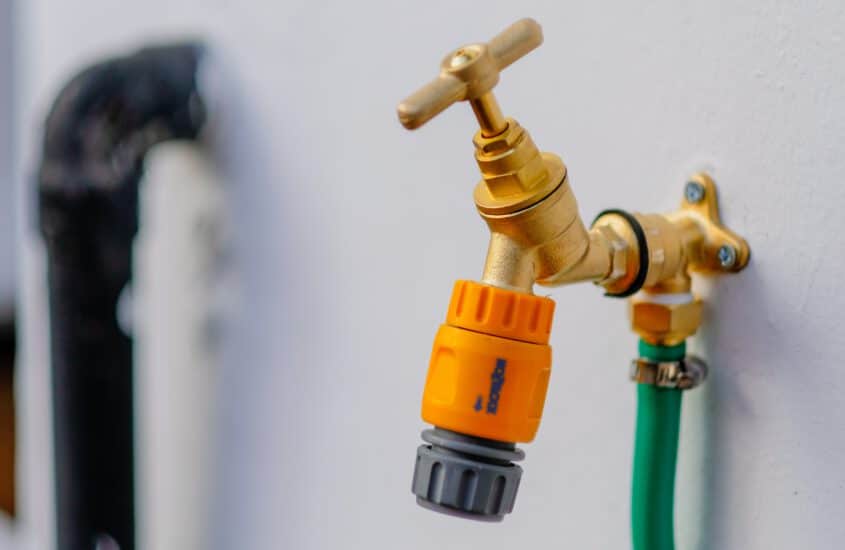Remotely control a smart water valve

How can a water tap or water pipe be opened or closed remotely? Turn off the water and turn it on with a Wi-Fi valve.
What do you need a smart water valve for?
There are applications in which it makes sense to be able to control the flow of a water pipe remotely. I myself have such a use case on the terrace: in our garage there is a vacuum-controlled water pump that pumps the collected rainwater from the cistern. We then use this water for watering the garden. On our terrace we have a water tap that is connected to the pump by means of a hose. If we turn on the tap on the terrace, a vacuum is created and the pump pumps. The problem is that the pump would also pump if a hose were to come loose somewhere at night or even burst. Then the pump would pump the contents of the cistern to who knows where and possibly cause water damage. That’s why I turn off the stopcock in the garage every evening. Just to be on the safe side. How cool would it be if you could do that remotely without having to run into the garage every time, right?
But there are other applications where such a smart valve makes sense:
- Switching off the water supply during a holiday
- Automatic detection of leaks with the help of a water sensor on the floor
- Detection of unusually high water withdrawal in the event of a burst pipe
- Closing of a pipe in case of danger of frost
- Measuring the flow rate for statistics
- Remote control of the water tap for lazy people like me
Different models and their advantages
There are actually several smart water valves. However, you have to be careful that you don’t accidentally choose a valve that is actually only intended for controlling the watering of flowers and is already overtaxed with the high water pressure of a normal water pipe.
The small battery-operated valves are the cheapest. There is a model (I won’t name it) that can be integrated into Apple Homekit, for example. This device originally cost €150. Then it received a huge pile of extremely bad reviews, so that you can now buy the device for around 35€. Due to a lack of power and build quality, this device tends to stay in the “open” position and can no longer be closed. It’s bad when you’re on holiday for a few weeks and your house is being filled with water.
This negative example teaches us the following three lessons:
- Do not rely on batteries for water valves
- Do not rely on cheap plastic parts for water valves that fail under high water pressure.
- If you buy cheap, you buy twice and water damage is expensive.
Which smart valve is recommended?
We find a professional valve with the “Grohe Sense Guard” *. The metal connection threads show that this is a completely different league from the plastic versions. The device is supplied with power via an external power supply unit and can be controlled remotely via an app using Wi-Fi, but it can do much more:
- Detects burst pipes, leaks and unusually high water consumption
- Shut-off function to prevent water damage
- Detection of flow rate and water pressure
- Measurement of system temperature to detect danger of frost
- Possibility to connect floor water sensors * for shut-off in case of liquid contact of the sensor
- Für Wireless LAN, Netzanschluss 230 V
- Für Einfamilienhäuser
There are three minor points of criticism of the device:
The part is actually quite expensive. On the other hand, what good is a cheap device that doesn’t work and then causes a lot of water damage?
The frost protection function is useless, at least in my application. Just because the unit detects frost temperatures and could then close the valve, I still have water in the pipe outside. Without a drain function, I don’t understand the point of this function.
Much more annoying for me is this point: the device only works with 2.4 GHz Wi-Fi. I’m still dreaming of a world in which I’ll be able to turn off the 2.4GHz in my home network and use the 5GHz network everywhere. Unfortunately, there are always manufacturers who do not implement 5GHz functions even in 2022. There would still be a need for optimisation here in a version 2. By the way, it would be even smarter if the device could be integrated into Apple Homekit, for example. But that is probably a bit too much to ask.
I didn’t want to hide these small points of criticism, maybe Grohe will listen to me. Nevertheless, the “Grohe Sense Guard” * is the best and most reliable solution for my application so far. I now save myself the daily walk to the garage and the opening and closing of the door when turning the main tap open or closed. Charming for me is also the counting of the flow rate. I’m already curious to find out how many litres of rainwater we actually use over the year. Doesn’t do me any good, but it’s just interesting and triggers my nerd heart.
* All links marked with an asterisk are Amazon affiliate links. We receive a percentage of the purchases made through them. Our recommendations are nevertheless honest and sincere.



